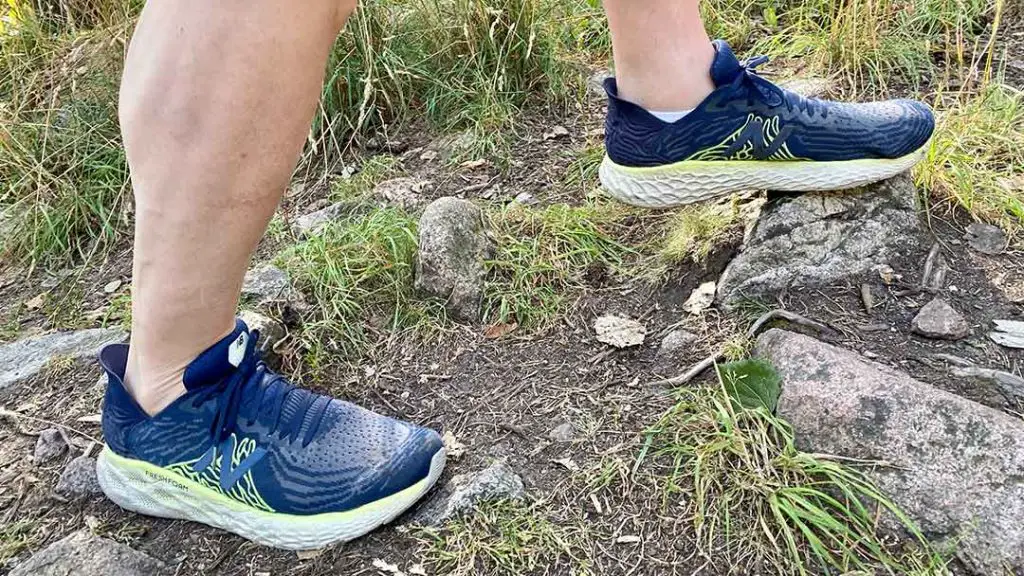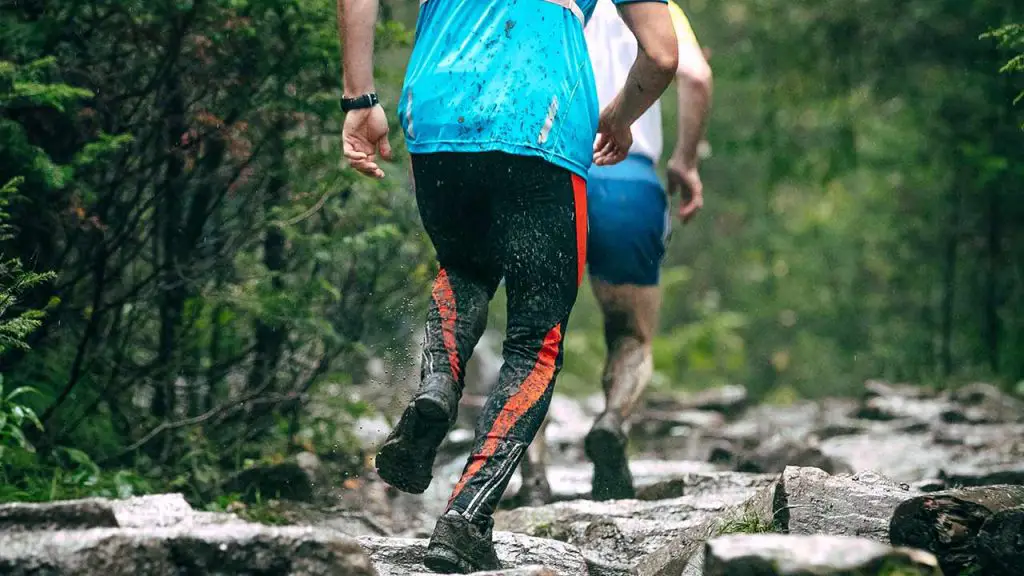Estimated read time: 5 minutes.
The answer to whether you can use your road running shoes for trail running varies depending on various factors. We’ve highlighted key points to help you to decide whether road shoes are suitable for trail surfaces.
Running is both a sport and an exercise. The kind of surface you pick will determine the type of running shoes to buy. Some runners prefer buying shoes for specific surfaces, while others use one pair of running shoes across all grounds.
However, the most common question, especially for beginners, is whether you can wear running shoes for trail running.
This article provides the main features of road running and trail running shoes. Also, we’ve shared reasons why it is not recommended to use road shoes on trail terrain.
Key Differences Between Road Running and Trail Shoes
As earlier mentioned, there are many differences between the features found in road shoes and trail running shoes. The best real-life example of this comparison could be between off-road cars and sports cars.
The physical appearance and components of these two shoes are pretty different. However, there are a few elements that trail and road shoes share. So let’s take you through the main differences:
Upper
Trail runners encounter all kinds of obstacles, especially on rough terrain. This is why they need running shoes with protective overlays to keep their feet safe from rocks and sharp sticks.
You will notice that most trail shoes have an extra strap to hold the tongue down and have a dual lacing design. These features make trail running shoes heavy and reduce breathability. Many companies dealing with trail shoes focus on balancing between protective and breathable materials.
On the contrary, road shoes are designed with a mesh upper to provide enough airflow to the feet. When engineering road running shoes, breathability is very vital. Unlike on unpredictable trails, your feet must remain dry, fresh, and healthy while running on roads. The upper part of a running shoe offers less protection and more comfortability.
Using these shoes on trails puts your feet at a high risk as they can be torn or cut by sharp rocks and sticks.
Outsoles
Most trail running shoes have wide outsoles to provide traction and protection for your feet. The outsoles of trail shoes are made from soft rubber to provide grip on surfaces like rocky trails. Also, the outsole design keeps your foot stable and supported on unstable terrains.
On the other hand, the outsole and toe box of road running shoes are narrow and built with more durable rubber. Road runners require shoes with hard outsoles to resist the repetitive impact of pavements and tarmac road surfaces. Therefore, wearing road running shoes on trail roads will reduce their durability.
Midsole
The function of the midsole is to provide cushioning and stability for your feet while running. Road shoes have softer midsoles to protect your feet against the direct impact on hard pavements. Trail running shoes have a firm midsole to provide stability on uneven terrain. However, the availability of multiple running shoe brands has made it complicated as they come with different midsole designs.
Trail running shoes are designed with rock plates to protect your leg and shoes from sharp and rocky terrain. Additionally, some trail shoes feature a complete outsole covering from heel to toe without any exposure.
Road running shoes, on the other hand, have exposed midsoles to make them lightweight. As such, using these shoes on trails will damage them significantly.
Tread Pattern and Lug Design
Trail running shoes have wider lugs to prevent debris and mud from holding on to your outsole. This is also to provide grip and stability on uneven surfaces. Trail run shoes require stickier rubber and wider treads to provide confidence when running on tree roots, rocks, and slippery terrain.
However, most road shoes have a smooth platform with flexible groves to provide forward momentum in a straight line.
When to Wear Trail Running Shoes
As aforementioned, trail shoes are specifically designed for muddy, rock, and uneven terrain. These shoes will provide enough traction and support on multiple surfaces.
Many runners prefer wearing trail shoes on the road when it rains or snows. The advantage of most trail shoes is that they are water resistant. This makes them perfect rainwear.
When to Wear Road Running Shoe
The latest designs of running shoes are lightweight and more flexible to offer your foot the comfort and support it needs. Road shoes are good to wear in hot and humid environments.
This prevents your feet from getting sweaty. Trail running shoes are not recommended for roads if you are going for faster workouts like tempo runs.
How to Choose Trail Running Shoes
If you are planning to buy trail running shoes, you must consider several factors. These factors will vary depending on the brand you are buying. Generally, these are the key features to look for in a new pair of trail running shoes:
Grip: As a trail runner, you need a pair of shoes that offer a good grip on technical terrain surfaces. Trail shoes have two types of grips, macro grip and micro grip, that work together to provide the stickiness you need on hard surfaces.
Protection: It’s hard to predict what you will step on technical trails. Therefore, you must choose a good pair of trail shoes made of protective materials for better traction on jagged rocks and other debris. Also, make sure the shoes have more cushioning and a gusseted tongue to reduce impact with rocks and offer more support.
Strong Construction: Running on trails involves small strides because you don’t know where you will step. Therefore, trail running shoes are designed to prevent excessive pronation. Knowing your foot pronation will help you choose the right pair of trail shoes.
Right Size: Wearing a fitting pair of trail shoes will make you comfortable when going about your activities. Overall, trail running shoes should fit tighter than normal shoes. Also, the right shoe needs a wider toe box for motion and stability.
How to Choose Road Running Shoes
In a world with advanced technology, it is easy to choose road running shoes without going to physical stores. In this section, we’ve shared things that road runners must consider when getting a road shoe:
Foot Strikes: Knowing your foot strike will help you to get a good pair of runner shoe. The different foot strikes are forefoot runner, heel striker, and mid-foot runner.
Weight: The best road running shoes have a lighter weight than other shoes. This is because they are made for softer surfaces without any debris or jagged rocks. Also, getting a lightweight pair of shoes will increase your speed.
Breathability: Road runners require shoes that allow free circulation of air. These shoes have a mesh upper, unlike trail shoes that have a rock plate for extra protection.
Support: Many athletes use race shoes for their daily exercises. The right running shoes should support whether going on long or short-distance races.
What is a Hybrid Shoe?
Thanks to modern technology, runners can now get a pair of hybrid shoes that serves trails and pavement surfaces. These shoes have more cushioning, which offers better support on harder surfaces. However, the challenge is creating a perfect shoe that balances the uneven terrain of trail roads and the smooth surface of roads and pavements.
Bottom Line – Can I wear Road Running Shoes on Trails?
Every shoes is designed for a specific purpose. This means they are equipped with the right features and support your feet and body on different surfaces. The overall design and features of road shoes are for softer surfaces than a trail shoe. Avoid wearing road running shoes on trails because they lack safety features like a rock plate that shields your foot from debris.
- How Many Laps Around a Track is a 5K: Your Guide - October 22, 2023
- When is Track and Field Season? - October 22, 2023
- Understanding the Length: How Long Is a Running Track? - October 22, 2023




